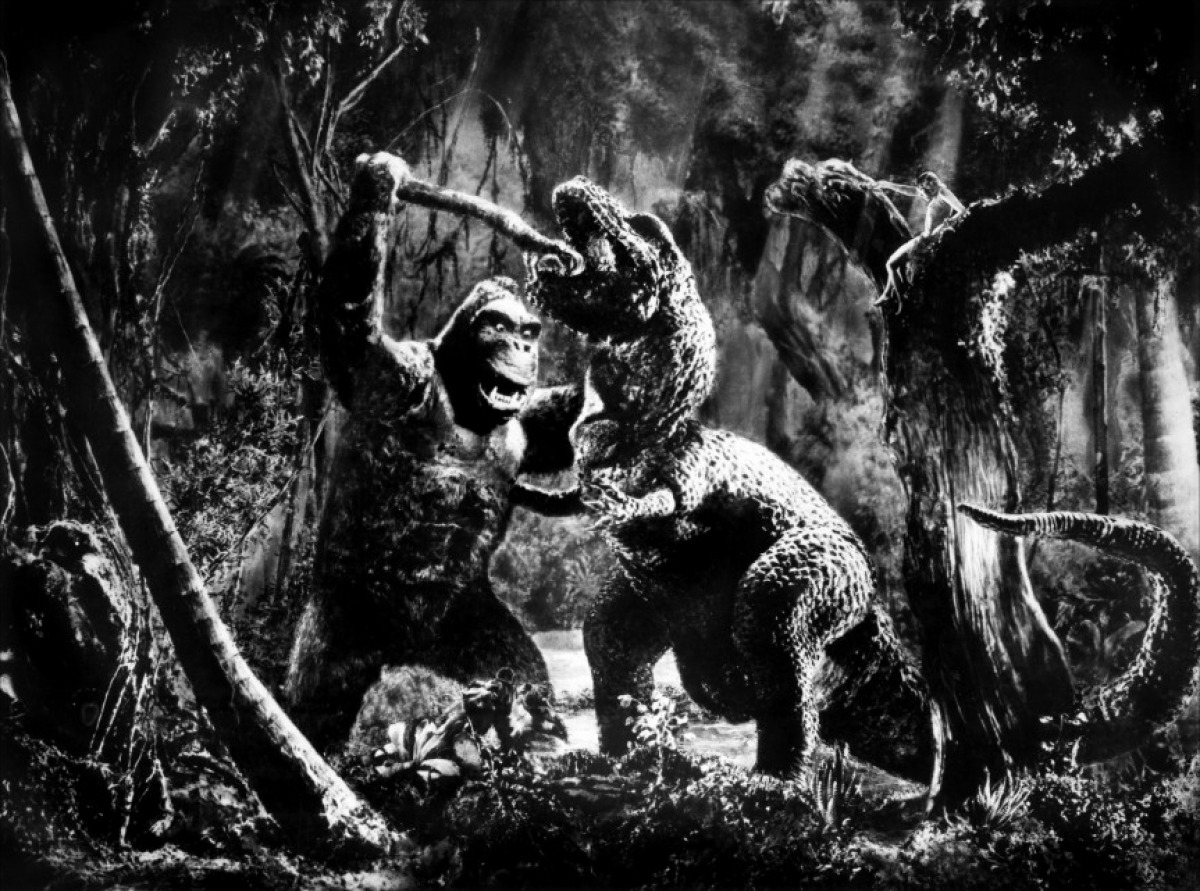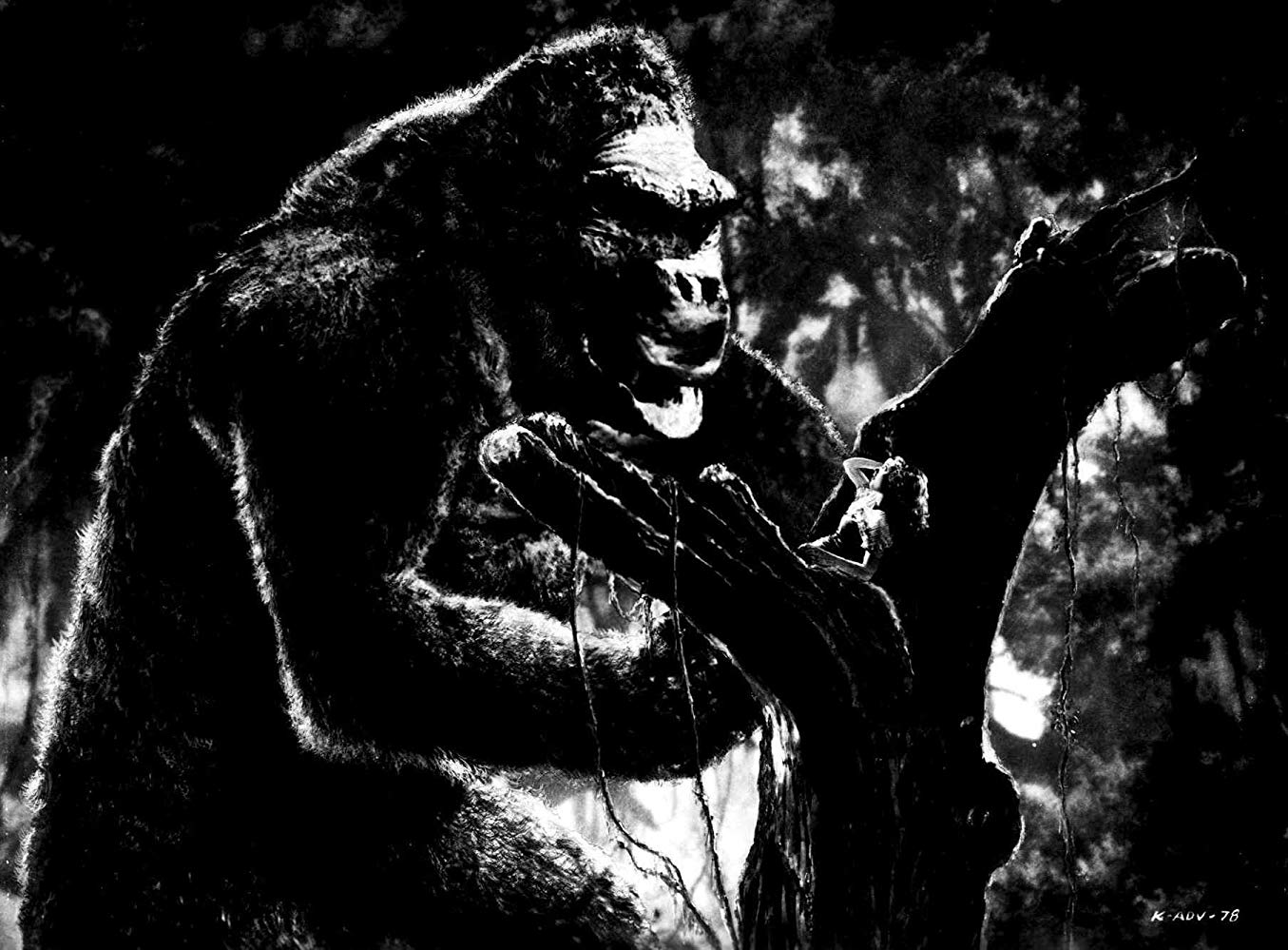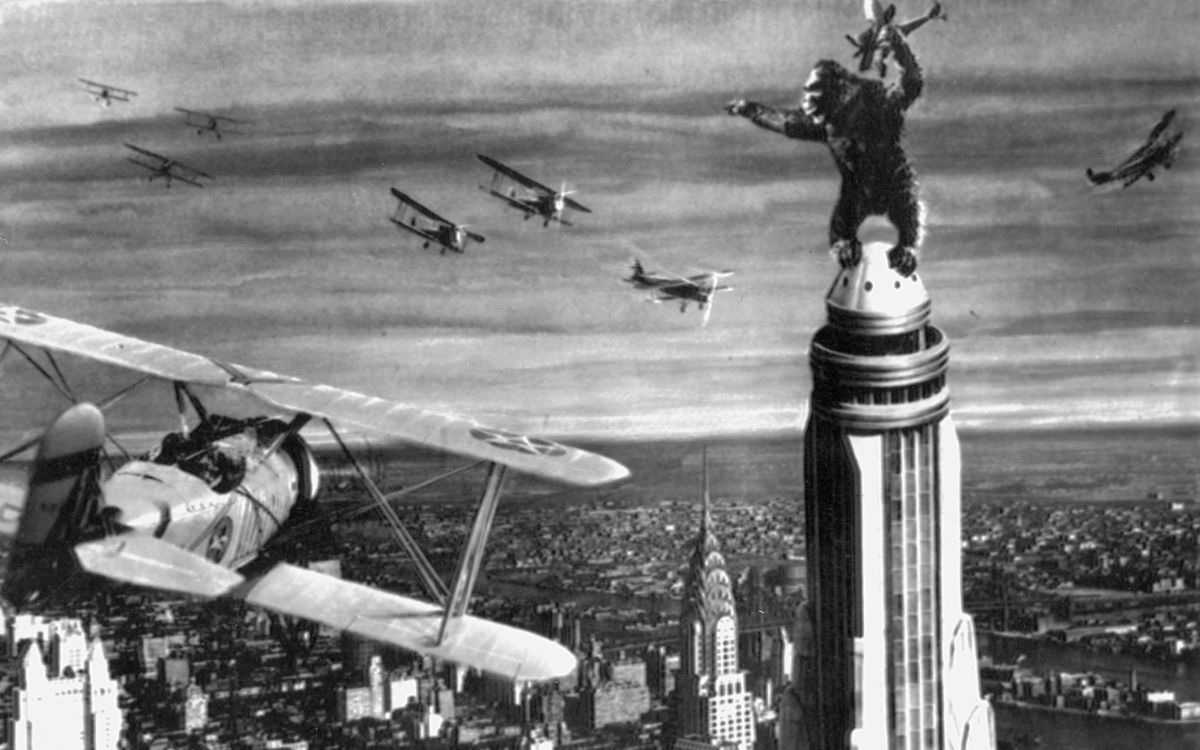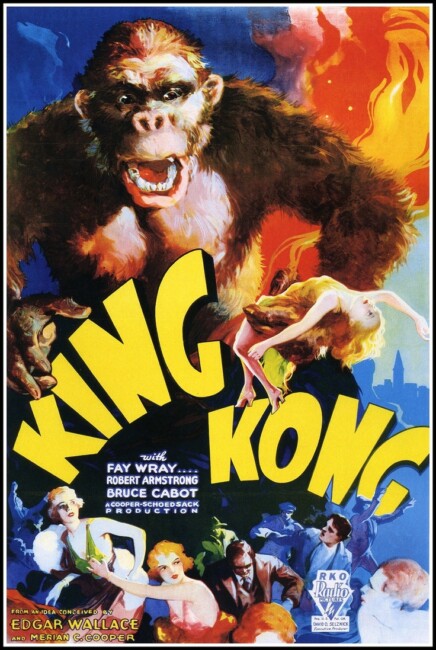USA. 1933.
Crew
Directors/Producers – Merian C. Cooper & Ernest B. Schoedsak, Screenplay – James Creelman & Ruth Rose, Story – Merian C. Cooper & Edgar Wallace, Photography (b&w) – Edward Lindon, J.O. Taylor & Vernon L. Walker, Music – Max Steiner, Visual Effects – Linwood Dunn, Special Effects – Willis O’Brien, Art Direction – Carroll Clark & Al Herman. Production Company – RKO Radio Pictures
Cast
Fay Wray (Ann Darrow), Bruce Cabot (John Driscoll), Robert Armstrong (Carl Denham), Frank Reicher (Captain Englehorn)
Plot
Sensationalistic movie producer Carl Denham hires a ship and unemployed starlet Ann Darrow and sets sail to a remote island in search of material for an adventure film. Once on the island, Ann is kidnapped by the natives and given as bride to Kong, a forty-foot tall ape. The crew struggle through a jungle, where monsters from the Cretaceous still survive, to rescue her. Denham then has the idea of gassing Kong and transporting him back to civilization and placing him on display. Once in New York, Kong breaks free of his confines and rampages through the city.
What can one say about King Kong? It is perhaps the greatest of all fantasy films, it is certainly the greatest monster movie ever made. King Kong is a template upon which almost all giant monster movies from The Beast from 20,000 Fathoms (1953) to Godzilla, King of the Monsters (1954) and Jurassic Park (1993) base themselves to some extent or another.
At its roots, King Kong belongs to the lost world genre. The lost world genre was a fantasy born of the Great Victorian Age of Exploration (and to a lesser extent the embryonic Victorian sciences of palaeontology and Darwinism) and popularised by writers like Jules Verne, Arthur Conan Doyle, Pierre Benoit, H. Rider Haggard and later Edgar Rice Burroughs. The Victorian Age of Empire was a point where parts of Africa, the Poles, even the remnants the American West were still uncharted and being discovered. (For a more detailed overview see Films About Lost Worlds).
The lost world was always a borderland world, one that inhabited the outermost fringes of civilization. Lost worlds teemed with exotic possibilities – prehistoric life, forgotten cities, lost races, great treasures. Symptomatically, the lost world fantasy began to die away around the end of the 1930s, fairly much the time that it could be said that almost every aspect of the physical world where lost civilizations and races could be hiding had been explored.

Willis O’Brien, the chief architect of the special effects in King Kong, was one of the first people to explore the lost world on film. Willis O’Brien had directed and created the special effects for a number of silent lost world films – The Dinosaur and the Missing Link: A Prehistoric Tragedy (1915), an inane light comedy set in prehistory, and other lost shorts featuring prehistoric monster such as 10,000 B.C. (1916), Prehistoric Poultry (1916), Curious Pets of Our Ancestors (1917), Along the Moonbeam Trail (1920), as well as The Ghost of Slumber Mountain (1918), a now lost film that was considered a classic of the silent prehistory genre. O’Brien then created the effects for the classic silent version of Conan Doyle’s The Lost World (1925). Directors Merian C. Cooper and Ernest B. Schoedsak had also previously made two silent films that specialized in the depiction of real-life social borderland worlds – Grass (1925), a documentary about the nomadic journey of an Iranian herding tribe and Chang (1927), a fictional piece about marauding elephants filmed in Siam (Thailand).
King Kong is a pinnacle of this early lost world genre. In the 1930s, the time that King Kong was made, the USA was at the height of The Great Depression, a time when a substantial number of people had been rendered penniless and dissolute. The lost world genre found a vogue during this time. The spin the 1930s cinema put on the genre was to contrast the lost world as an idealised, almost Utopian realm that was seen in many ways as preferable to the attendant worries of civilization. Other films of the era such as Tarzan the Ape Man (1932) and Lost Horizon (1937) both held the view that happiness in life could be found by abandoning civilization and returning to a much simpler, untroubled way of life in undiscovered parts of the globe.
King Kong, like much of Merian C. Cooper and Ernest B. Schoedsak’s other work, revels in the primality of cultures living closer to nature. In this prehistoric borderland world, Kong is seen to be the king of the jungle and the film spends much time revelling in the primal majesty of his glory. The underlying thesis of King Kong is that civilization corrupts the greatness of the jungle beast. The end of the film where Kong is tragically cut down by biplanes as he tries to climb the then tallest peak in New York City, the Empire State Building, is a paean for such primal majesty being brought down by civilization. (Indeed, King Kong has single-handedly afforded the Empire State an almost mythic status).

Much has been made of the strong sexual subtext of King Kong, especially a scene cut from the original release where Kong holds Fay Wray in his paw and tears her clothes off – said horror writer Robert Bloch: “If Freud didn’t exist before King Kong, it would be necessary to invent him” – although this seems an overly literal analysis of the film. Certainly, it is there – what else is one to make of the seemingly ludicrous notion of a love affair between a 40-foot ape and a blonde starlet. (There has been enormous amount of comedic speculation devoted to how such a relationship might ever be consummated). There is an extraordinary dreamy quality to the film. Rather than any overtly sexual metaphors, King Kong hovers on the edge of Beauty and the Beast-like fairy-tale more than it does a monster movie. No other monster movie has succeeded in depicting the relationship between the ferocious yet strangely sympathetic monster and the innocent heroine as King Kong does. In fact, few other monster movies succeed in investing the beast with any character, in doing anything other than simply regarding it as a marauding monster.
The quality of Willis O’Brien’s effects is stunning. The level of detail – little touches such as Kong’s mannerisms, shaking his head and rubbing his eyes as he is hit by the gas bombs, or the twitching of the not-quite dead stegosaurus’s tail – is incredible. The amazingly violent battle between Kong and a triceratops that goes on for several minutes is perhaps the finest piece of stop-motion animation ever created for the screen.
Many scenes were cut from the film following its original 1933 premiere. The most notable scenes to go were the ones where Kong peels Fay Wray’s clothes from her and the scene where he attacks the sailors crossing the ravine and shakes them off to their deaths below. There are several other brief shots in which Kong kills natives that were also cut. These were later restored in the 1980s, although the cut print is still the one that circulates on tv.

Willis O’Brien, Ernest B. Schoedsak, Merian C. Cooper, Ruth Rose, Max Steiner and stars Robert Armstrong and Frank Reicher returned to make the likeably silly sequel The Son of Kong (1933). In the 1960s, Japan’s Toho Studios revived Kong to take on their biggest star in King Kong Vs. Godzilla (1962) and then spun Kong off for a solo effort King Kong Escapes (1967). Producer Dino De Laurentiis made the infamous remake King Kong (1976), which is reviled by all fans of the original. De Laurentiis then later made an even worse sequel King Kong Lives (1986). Peter Jackson conducted a further remake King Kong (2005), which extrudes the elements of the original out into a superb epic. Kong: Skull Island (2017) was a reboot of the series, followed by Godzilla vs. Kong (2021) and Godzilla x Kong: The New Empire (2024). There were two animated tv series with the Japanese The King Kong Show (1966-8) and then the US made Kong: The Animated Series (2000-1). The latter also had two films spinoffs with Kong, King of Atlantis (2005) and Kong: Return to the Jungle (2006). Kong also makes cameos in The Lego Batman Movie (2017), Ready Player One (2018) and Space Jam: A New Legacy (2021). Also of interest is I’m King Kong!: The Exploits of Merian C. Cooper (2005), a documentary about Merian C. Cooper.
There were numerous imitations of King Kong. Willis O’Brien, Ernest B. Schoedsak, Merian C. Cooper, screenwriter Ruth Rose and star Robert Armstrong returned to make Mighty Joe Young (1949), another giant ape film that is almost as good as King Kong. There were a number of giant ape copycats such as White Pongo (1945), Konga (1961), King of Kong Island (1968), The Mighty Gorga (1969), King of the Lost World (2005) and the animated Kong, King of Atlantis (2005), even an adult version Kinky Kong (2006). Kong has also been spoofed in films such as Flesh Gordon (1974), Schlock (1973), Herbie Rides Again (1974), The Pink Panther Strikes Again (1976), Queen Kong (1976), Monster in the Closet (1986), Flesh Gordon Meets the Cosmic Cheerleaders (1991), The Nutty Professor (1996), Frida (2002), George of the Jungle 2 (2003), Chicken Little (2005), Wallace & Gromit in The Curse of the Were-Rabbit (2005). Be Kind Rewind (2008) and Ralph Breaks the Internet (2018). The makers of the videogame Donkey Kong (1981) ended up being sued for unauthorised copyright violation. Tom Waits even wrote a song tribute King Kong (2004).
Merian C. Cooper and Ernest B. Schoedsak made several other genre films together that include the excellent human hunting film The Most Dangerous Game (1932), The Monkey’s Paw (1932) and the miniaturized people film Dr Cyclops (1940). Merian C. Cooper also produced the H. Rider Haggard lost world adaptation She (1935).
Trailer here


